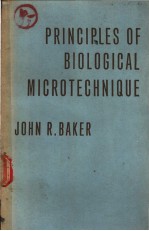图书介绍
PRINCIPLES OF BIOLOGICAL MICROTECHNIQUEpdf电子书版本下载

- 著
- 出版社:
- ISBN:
- 出版时间:未知
- 标注页数:357页
- 文件大小:18MB
- 文件页数:359页
- 主题词:
PDF下载
下载说明
PRINCIPLES OF BIOLOGICAL MICROTECHNIQUEPDF格式电子书版下载
下载的文件为RAR压缩包。需要使用解压软件进行解压得到PDF格式图书。建议使用BT下载工具Free Download Manager进行下载,简称FDM(免费,没有广告,支持多平台)。本站资源全部打包为BT种子。所以需要使用专业的BT下载软件进行下载。如 BitComet qBittorrent uTorrent等BT下载工具。迅雷目前由于本站不是热门资源。不推荐使用!后期资源热门了。安装了迅雷也可以迅雷进行下载!
(文件页数 要大于 标注页数,上中下等多册电子书除外)
注意:本站所有压缩包均有解压码: 点击下载压缩包解压工具
图书目录
PART Ⅰ:FIXATION 15
1 Introduction to Fixation 19
2 The Reactions of Fixatives with Proteins.1.The Visible Effects 31
3 The Reactions of Fixatives with Proteins.2.The Chemi-cal Changes 44
4 The Reactions of Fixatives with Tissues and Cells:Methods of Research 66
5 Primary Fixatives Considered Separately.1.Coagulants 89
6 Primary Fixatives Considered Separately.2.Non-coagulants 111
7 Fixative Mixtures 139
PART Ⅱ:DYEING 153
8 Introduction to the Chemical Composition of Dyes 155
9 The Classification of Dyes 169
10 The Direct Attachment of Dyes to Tissues 187
11 The Indirect Attachment of Dyes to Tissues 207
12 The Differential Action of Dyes 228
13 Metachromasy 243
14 The Blood Dyes 262
15 Introduction to Vital Colouring 274
16 The Mode of Action of Vital Dyes 284
17 A Comparison between Dyeing and other Processes of Colouring 296
APPENDIX 313
1 The composition of solutions expressed as percentages:conventions adopted in this book 313
2 Experiments on fixation 314
3 Experiments on dyeing 321
4 Use of the word‘chromatin’ 327
5 Notes on spelling 329
List of References 331
Index 345
Fig.1.Graphical representation of the changes in volume undergone by gelatine/albumin gels during 18 hours in various fixatives 36
Fig.2.Pipettes used in the measurement of the rate of penetration of fixatives into gelatine/albumin gel 38
Fig.3.Graph showing the rate of penetration of fixatives into gelatine/albumin gel 39
Fig.4.Protein coagula seen under the microscope 41
Fig.5(plate).A,lobes of the liver of the rabbit left for 25 hours in fixatives and then cut across B—E,photomicrographs illustrating Young’s ex-periments on the addition of indifferent salts to fixatives2 67
Fig.6.A cell from the intestine of Oniscus (woodlouse),fixed in mercuric chloride:to show the coagulation of protoplasm 67
Fig.7.Graph showing the thickness of rabbit-liver fixed by a saturated aqueous solution of mercuric chlor-ide in various times 68
Fig.8(plate).The effect of ftxatives on cultured cells from the chorioid or sclerotic coat of the eye of the chick embyro 70
Fig.9(plate).Sections of the testis of the mouse,to show good and bad fixation 74
Fig.10.Outlines of the fully-grown primary spermatocyte of the snail,Helix aspersa,to show the effect of fixa-tion and subsequent treatment on the size of the cell 79
Fig.11.Graph showing the effect of fixation and subsequent treatment on the volume of the nuclei of cartilage-cells 80
Fig.12.Graph showing how the volume of the eggs of Ar-bacia pustulosa is affected by the addition of non-fixative salts to formaldehyde solution 82
Fig.13.Diagram showing the coefficient of elasticity of the belly-muscle of the cat,fixed in various ways 87
Fig.14.Graphical representation of the ions present in a 2.5% aqueous solution of potassium dichromate and in a solution of chromium trioxide containing the same weight of chromium 105
Fig.15.Photomicrographs of lecithin smeared on glass.A,in distilled water,showing outgrowth of myelin forms;B,in a concentrated solution of calcium chloride,showing absence of myelin forms 115
Fig.16.Three Ringk?rner and a cap or hood (Kapuze)formed by partial solution of lipid globules:osmium preparations 125
Fig.17.Graph showing the transmission of light through a layer I cm thick of basic fuchsine, 0.00062% aqueous 161
Fig.18.Graph showing the reciprocals of the transmission of light through a layer I cm thick of basic fuchsine,0.00062% aqueous 162
Fig.19.Graph showing the optical density of a layer I cm thick of basic fuchsine, 0.00062% aqueous 163
Fig.20.Graph showing the transmission of light through a layer I cm thick of acid fuchsine, 0.00293% aqueous 165
Fig.21(plate).Haematoxylon campechianum 172
Fig.22(plate).The cochineal insect and its food-plant 176
Fig.23(plate).Apparatus for cataphoretie experiments with dyes 189
Fig.24(plate). Ehrlich at the age of 24 193
Fig.25.Diagrammatic representation of the dyeing of coilodion by typical basic,amphoteric,and acid dyes 194
Fig.26.Diagrammatic representation of the dyeing of gela-tine by typical basic,amphoteric,and acid dyes 195
Fig.27.Graph showing the transmission of light of various wave-lengths through toluidine blue solution 250
Fig.28(coloured plate).A,human blood from a patient with mycloid leucaemia;coloured by Ehrlich’s‘Triacid’ dye (from Ehrlich & Lazarus169)B,normal human blood dyed by Leishman’s method (from Carleton & Short,106 by permission of Messrs Longmans,Green & Co.) 264
Fig.29(plate).Ehrlich at about the time when his work on vital dyes was merging into chemotherapy 274